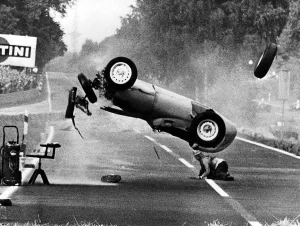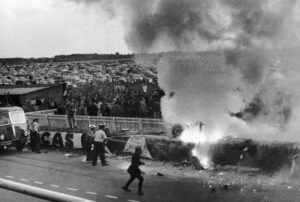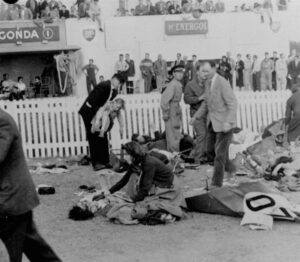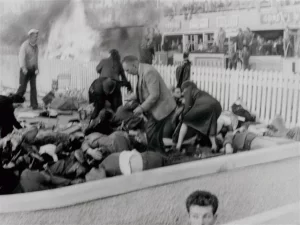
 Car racing has been around since cars have been around, and for the most part, professional car racing has been a fairly safe event, but that isn’t always the case. One of the big races is the Le Mans 24 race, which was organized by France’s Automobile Club de L’Ouest, was first held in May 1923. Since that time, the race has been held nearly every June. The race is an unusual kind of race in that it begins at 4 pm on a Saturday afternoon. It lasts for the next 24 hours over a 13-kilometer course running through the country roads near Le Mans. The winner is the racer who covers the greatest distance in the 24-hour period. Some of the rules have changed for safety purposes. Originally each car could only have a single driver. Then the rule was changed in 1970, allowing each car to have two drivers. These days, three are required. Eddie Hall managed to complete the entire race alone in the 1950 edition of Le Mans 24 and is the only person in history to do so. Several other drivers have tried in the early years of the event, but then it was outlawed.
Car racing has been around since cars have been around, and for the most part, professional car racing has been a fairly safe event, but that isn’t always the case. One of the big races is the Le Mans 24 race, which was organized by France’s Automobile Club de L’Ouest, was first held in May 1923. Since that time, the race has been held nearly every June. The race is an unusual kind of race in that it begins at 4 pm on a Saturday afternoon. It lasts for the next 24 hours over a 13-kilometer course running through the country roads near Le Mans. The winner is the racer who covers the greatest distance in the 24-hour period. Some of the rules have changed for safety purposes. Originally each car could only have a single driver. Then the rule was changed in 1970, allowing each car to have two drivers. These days, three are required. Eddie Hall managed to complete the entire race alone in the 1950 edition of Le Mans 24 and is the only person in history to do so. Several other drivers have tried in the early years of the event, but then it was outlawed.
In 1952, during the one driver years, Pierre Levegh, a Frenchman driving alone, might have won the race, but he made one single mistake in the last hour. Levegh was invited to join the Mercedes-Benz team three years later. Their 300SLR was to be outfitted with a new innovation, an air brake that would enhance cornering. It must have been an exciting thought, but Levegh complained that the course was too narrow near the pit-stop area and the grandstand. He was worried about the tight turn. His observation was proven to be almost prophetic. In that very turn, as Levegh was racing for the lead near the tight pit-stop area, he swerved to avoid fellow racer Mike Hawthorn’s Jaguar moving toward the pits. Levegh’s car, which was traveling at about 150 miles per hour, hit Lance Macklin’s Austin-Healey and shot upward. The car crashed into the grandstand and car parts sprayed straight into the crowd. In the fiery crash, Levegh and more than 80 spectators, who were packed into the grandstand, lost their lives. The race went on despite the horrific accident, and in the end, it was thought that Hawthorn won. The remaining spectators had to stay where they were, because if they had left the area, they would have blocked the ambulances called to pick up the dead and injured.

 Grand Prix races in Germany and Switzerland, which had been scheduled for later that year were cancelled. Spain and Mexico temporarily banned motor racing following the 1955 Le Mans tragedy. Of course, the bans didn’t last very long…just long enough for people to realize that safety had to be a priority, and to put safety measures in place to protect the crowds. That doesn’t mean that tragedy can’t happen at a race, but it is usually on a much smaller scale.
Grand Prix races in Germany and Switzerland, which had been scheduled for later that year were cancelled. Spain and Mexico temporarily banned motor racing following the 1955 Le Mans tragedy. Of course, the bans didn’t last very long…just long enough for people to realize that safety had to be a priority, and to put safety measures in place to protect the crowds. That doesn’t mean that tragedy can’t happen at a race, but it is usually on a much smaller scale.


Leave a Reply